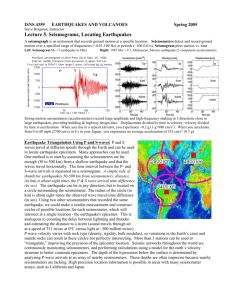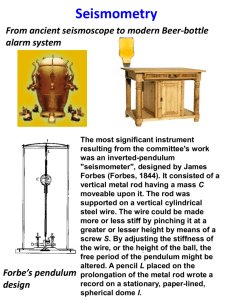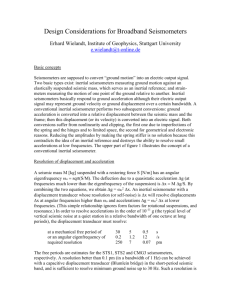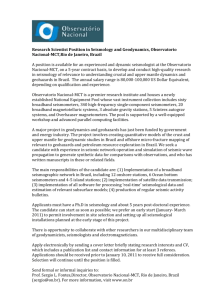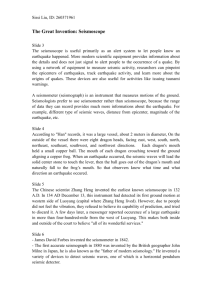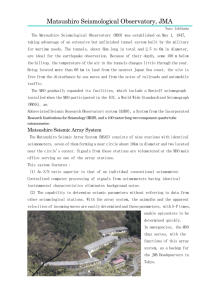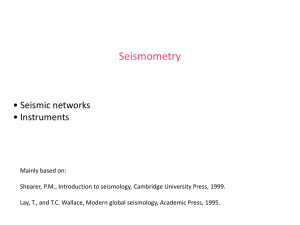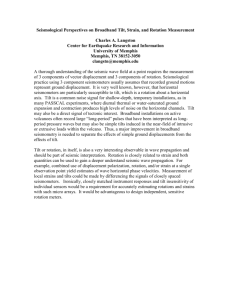Document
advertisement
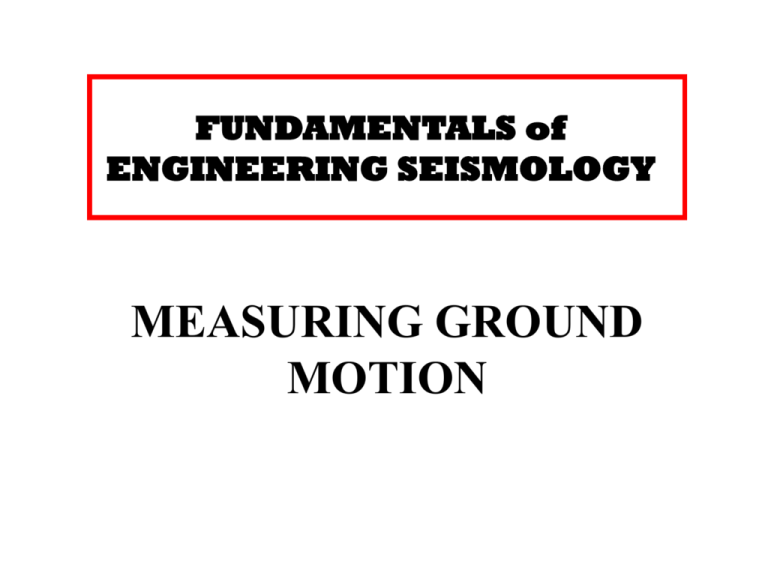
FUNDAMENTALS of ENGINEERING SEISMOLOGY MEASURING GROUND MOTION MEASURING EARTHQUAKES The first known instrument for earthquakes measurement is the Chang seismoscope built in China in 132 B.C. Balls were held in the dragons’ mouths by lever devices connected to an internal pendulum. The direction of the epicenter was reputed to be indicated by the first ball released. Jargon seismoscope – an instrument that documents the occurrence of ground motion (but does not record it over time) seismometer – an instrument that senses ground motion and converts the motion into some form of signal accelerometer – a seismometer that records acceleration, also known as strong ground motion geophone – another name for a seismometer, commonly used in active source seismology More Jargon seismograph – a system of instruments that detects and records ground motion as a function of time seismogram – the actual record of ground motion produce by a seismograph seismometry – the design and development of seismic recording systems data logger – device that converts analog to digital signal and stores the signal Chronology of Instrumentation 132 – first seismoscope (Heng, China) 1751 – seismoscope which etched in sand (Bina, Italy) 1784 – first attempt to record ground motion as a function of time using a series of seismoscopes (Cavalli, Italy) 1875 – first true seismograph (Cecchi, Italy) Chronology of Instrumentation 1889 – first known seismogram from a distant earthquake is generated (Rebeur-Paschwitz, Germany) 1914 – first seismometer to use electromagnetic transducer to sense ground motion (Galitzin, Russia) 1969 – first digital seismograph (data recorded in discrete samples on a magnetic tape) (U.S. researchers) 1990s – broadcast of real time seismic data via internet How Seismometers Work Since the measurements are done in a moving reference frame (the earth’s surface), almost all seismic sensors are based on the inertia of a suspended mass, which will tend to remain stationary in response to external motion. The relative motion between the suspended mass and the ground will then be a Havskov and Alguacil function of the ground’s motion Fundamental Idea: To record ground motion a seismometer must be decoupled from the ground. If the seismometer moves with the ground then no motion will be recorded. Principles of seismographs Doors in CAR College (swing on tilted axis) Electro-magnetic sensor. Velocity transducer: moving coil within a magnetic field Havskov and Alguacil The current is proportional to the mass velocity Analog Strong-Motion Accelerographs USGS - DAVID BOORE 11 Analog accelerographs These instruments produce traces of the ground acceleration against time on film or paper. Most widely used analog instrument is the Kinemeterics SMA-1 Three important disadvantages of analog accelerographs: 1. Always triggered by a specified threshold of acceleration which means the first motions are often not recorded 2. The limitation of natural frequency of analog instruments. They are generally limited to about 25 Hz. 3. It is necessary to digitize the traces of analog instruments as they record on film or paper (most important disadvantage as it is the prime source of noise) 12 Strong Ground Motion Parameters – Data Processing Dr. Sinan Akkar Modern seismic monitoring Modern Seismometers • A conductive (metallic) mass is decoupled from surrounding magnets inside a protective casing. • Ground motion causes the mass to move relative to the surrounding magnetic field. • This creates an electric current with an amplitude that is proportional to the velocity of the mass. Modern Seismometers • This electric current is transmitted to a digitizer which converts the analog (continuous) signal to a digital (discrete) signal. • Each discrete observation of the current is written to a computer disk along with the corresponding time. • These times series’ are downloaded to computers and processed/analyzed. Digital accelerographs Digital accelerographs came into operation almost 50 years after the first analog strong motion recorders. Digital instruments provide a solution to the three disadvantages associated with the earlier accelerographs: 1. They operate continuously and by use of pre-event memory are able to retain the first wave arrivals. 2. Their dynamic range is much wider, the transducers having natural frequencies of 50 to 100 Hz or even higher 3. Analog-to-digital conversion is performed within the instrument, thus obviating the need to digitize the records. USGS - DAVID BOORE Strong Ground Motion Parameters – Data Processing 16 Dr. Sinan Akkar Sensitivity • The sensitivity of seismometers to ground motion depends on the frequency of the motion. • The variation of sensitivity with frequency is known as the instrument response of a seismometer. Amplitude and frequency range The amplitude and frequency range of seismic signals is very large. The smallest motion of interest is limited by the ground noise. The smallest motion might be as small as or smaller than 0.1 nm. What is the largest motion? Considering that a fault can have a displacement of 10 m during an earthquake, this value could be considered the largest motion. This represents a dynamic range of (10/10-10) = 1011. This is a very large range and it will probably never be possible to make one sensor covering it. Similarly, the frequency band starts as low as 0.00001 Hz (earth tides) and could go to 1000 Hz. These values are of course the extremes, but a good quality all round seismic station for local and global studies should at least cover the frequency band 0.01 to 100 Hz and earth motions from 1 nm to 10 m. Havskov and Alguacil Havskov and Alguacil It is not possible to make one single instrument covering this range of values and instruments with different gain and frequency response are used for different ranges of frequency and amplitude. Sensors are labeled e.g. short period (SP), long period (LP) or strong motion. Today, it is possible to make instruments with a relatively large dynamic and frequency range (so called broad band instruments (BB) or very broad band (VBB)) and the tendency is to go in the direction of increasing both the dynamic and frequency range. Havskov and Alguacil From IASPEI-NMSOP Instrument Response • Seismometers that are sensitive to ground motions with high frequencies are called short-period seismometers. They are useful for recording nearby (within 2000 km) earthquakes and are also used in active source seismic experiments. • Seismometers that are sensitive to ground motions with long frequencies are called long-period seismometers. They are useful for recording teleseismic earthquakes, normal modes, and earth tides. Instrument Response • The most advanced seismometers are called broadband seismometers and can record both high and low frequencies – they record over a broad band of frequencies. • Broadband seismometers are much more expensive, and more easily damaged, than short period seismometers. Mechanical sensor Damping oscillator constants: h d 2mω0 ω0 k m z(t)= y(t)-x(t) relative displacement Damping force Kz dz mz mx Spring force my z 2h0 z 02 z x Asymptotic Response for ω0 Small and Large Oscillator equation: z 2hω0 z ω02 z x where ω0 2πf 0 2π / T0 is the oscillator natural frequency in radians. For f 0 0 : z x A displacement meter For f 0 : z 1 ω02 x An acceleration meter Mechanical sensor z 2h0 z 02 z x Input harmonic motion (frequency domain) x(t ) X ( )e jt z (t ) Z ( )e jt x U ( )e 2 j t z j Z ( )e jt z 2 Z ( )e jt Z ( ) 2 Td ( ) 2 X ( ) 0 2 20 hj Ad ( ) Td ( ) 2 2 0 2 2 4h 2 202 Im Td ( ) 1 2h0 d ( ) tan tan 2 2 Re T ( ) d 0 1 Ta ( ) Z ( ) 1 2 X ( ) 02 2 20 hj Aa ( ) Ta ( ) Z A 1 02 2 4h2 202 2 From displacement to velocity and to acceleration: divide by the frequency (remove a zero from the origin) Low sensitivity in displacement Flat response in acceleration Havskov and Alguacil accelerometer From mechanical seismometer to velocity transducer and to accelerometer, multiply by the frequency (add a zero in the origin) Displacement at very low frequencies produce very low accelerations 2 ( x f x , where x is the ground displacement and f the frequency). It is therefore understandable why it is so difficult to produce seismometers that are sensitive to low frequency motion. Today, purely mechanical sensors are only constructed to have resonance frequencies down to about 1.0 Hz (short period sensors), while sensors that can measure lower frequencies are based on the Force Balance Principle (FBA) of measuring acceleration directly. Force-balance (Servo) Sensors The force-balance accelerometer is shown below where a pendulous, high-magnetic permeability mass is hung from a hinge. The "down" or "null position" is detected by the null detector and the counterbalancing force is provided by a magnetic coil. “Broadband” seismometers (velocity sensors, using electronics to extend the frequency to low values) are starting to be used in engineering seismology: the boundary between traditional strong-motion and weakmotion seismology is becoming blurred (indistinct, fuzzy). Digital strong-motion recording • Broadband: nominally flat response from dc to at least 40 Hz – But noise/ baseline problems can limit low-frequency information – High-frequency limit generally not a problem because these frequencies are generally filtered out of the motion by natural processes (exception: very hard rock sites) • High dynamic range (ADC 16 bits or higher) • Pre-event data usually available ADC (Analog-digital conversion) • Quanta (least digital count) Q = 2Y/2N Where ±Y = full-scale range and N = number of bits used in ADC • Dynamic Range (DR) DR(decibels) = 20 log Y/Q = 20 log 2(N-1) Examples • Y = 2g = 2*981 cm/s/s • N = 12 bits Q = .96 cm/s2 DR = 66 db • N = 24 bits Q = 0.00023 cm/s2 DR = 138 db Magnification curves Note notch, due to Earth noise; this noise can be seen in recordings from modern broadband instruments. Not shown: broadband (0.02—DC sec) 35 Seismic Sensors and Seismometry, Prof. E. Wielandt, Dr. C. Milkereit From New Manual of Seismological Observatory Practice- P. Bormann Editor Analogue and Digital Records of small earthquake from Adjacent Instruments at Procisa Nuova (Italy) P-arrival lost in analog recording Summary • The first legitimate seismometer was built in 1875. • The first seismogram of a distant earthquake was recorded in 1889. • The first digital seismometers were deployed in the early 1970s. • The first broadband seismometers were deployed in the 1980s Summary • Seismometers record motions as small as 1.0-9 m, at frequencies of about 0.001 Hz to 100 Hz. • There are over 10,000 seismometers around the world that are continually recording ground motion. Seismograms • Seismograms are records of Earth’s motion as a function of time. Seismograms • Seismograms record ground motion in terms of – displacement – velocity – acceleration • Normally a seismometer samples ground motion about 20 times per second (20 Hz), but this number can be as high as 500 Hz. Modern accelerometers sample at 200 sps. Seismograms are composed of “phases” Seismograms • Ground motion is a vector (whether it is displacement, velocity or acceleration), so it takes 3 numbers to describe it. Thus, seismometers generally have three components: – Vertical (up is positive) – North-South (north is positive) – East-west (east is positive) } horizontals Components of Motion There are simple mathematical operations that allow seismologists to rotate (abstractly) the horizontal components: N earthquake Original Coordinate System seismometer W E S Components of Motion There are simple mathematical operations that allow seismologists to rotate (abstractly) the horizontal components: Transverse N earthquake seismometer W E Modified Coordinate System The new components are called: (1) Radial, R Radial S (2) Transverse, T Oaxaca, Mexico earthquake recorded by seismometer in Alaska. Networks and Arrays Broad-band Seismograph Networks Many networks of instruments, both traditional “strong-motion” and, more recently, very broad-band, high dynamicrange sensors and dataloggers Kyoshin Net (K-NET) Japanese strong motion network http://www.k-net.bosai.go.jp • 1000 digital instruments installed after the Kobe earthquake of 1995 • free field stations with an average spacing of 25 km • velocity profile of each station up to 20 m by downhole measurement • data are transmitted to the Control Center and released on Internet in 3-4 hours after the event • more than 2000 accelerograms recorded in 4 years Reminder: Play Chuettsu and Tottori movies Chuetsu Tottori A number of web sites provide data from instrument networks • But no single web site containing data from all over the world. • An effort is still need to add broad-band data into the more traditional data sets. USGS - DAVID BOORE 57 USGS - DAVID BOORE 58 USGS - DAVID BOORE 59 USGS - DAVID BOORE 60 WEB SITES – DATABASES NGA - http://peer.berkeley.edu/nga/ END
